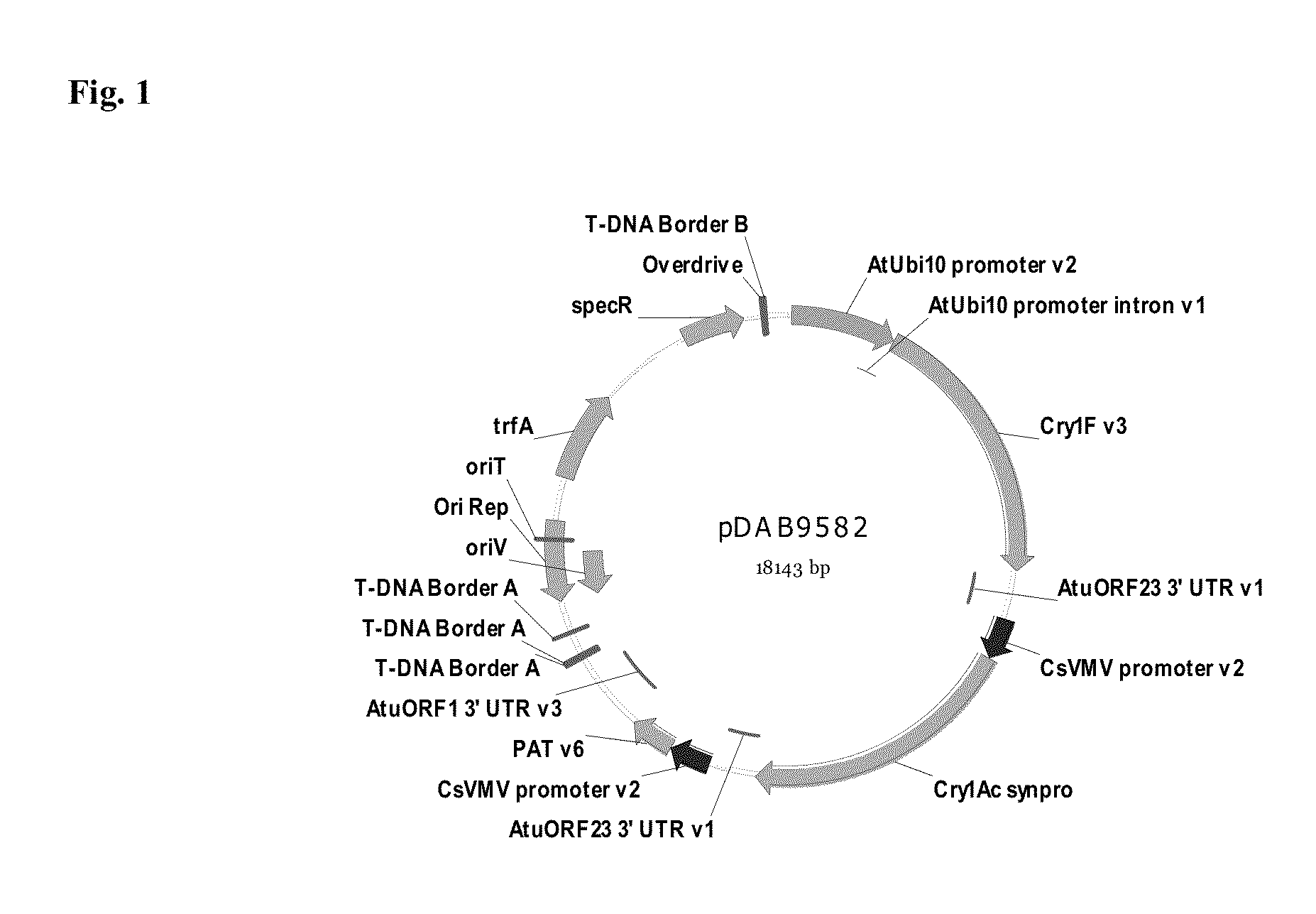Insect resistant and herbicide tolerant soybean event 9582.814.19.1
a technology of insect resistance and herbicide resistance, applied in the field of insect resistance and herbicide tolerance of soybean event 9582.814.19.1, can solve the problem that the method may not be useful in discriminating between different events
- Summary
- Abstract
- Description
- Claims
- Application Information
AI Technical Summary
Benefits of technology
Problems solved by technology
Method used
Image
Examples
example 1
Transformation and Selection of the Cry1F and Cry1Ac Soybean Event pDAB9582.814.19.1
[0131]Transgenic soybean (Glycine max) containing the soybean event pDAB9582.814.19.1 was generated through Agrobacterium-mediated transformation of soybean cotyledonary node explants. The disarmed Agrobacterium strain EHA101 (Hood et al., 1993), carrying the binary vector pDAB9582 (FIG. 1) containing the selectable marker, pat v6, and the genes of interest, cry1F v3 and cry1Ac synpro, within the T-strand DNA region, was used to initiate transformation. The DNA sequence for pDAB9582 is given in SEQ ID NO:3, which is annotated below in Table 1.
[0132]
TABLE 1Gene elements located on pDAB9582.bp (SEQ IDConstructNO: 3)elementReference 272-1593AtUbi10Callis, et al., (1990) J. Biol. Chem.,Promoter265: 12486-124931602-5048Cry1FReferenced above5151-5607ORF23 3′UTRU.S. Pat. No. 5,428,1475671-6187CsVMVVerdaguer et al., (1996) Plant Mol.PromoterBiol., 31: 1129-11396197-9667Cry 1ACReferenced above 9701-10157ORF23...
example 2
Characterization of Protein Expression in Soybean Event pDAB9582.814.19.1
[0136]The biochemical properties of the recombinant Cry1F, Cry1Ac, and PAT proteins expressed in soybean event 9582.814.19.1 were characterized. Quantitative enzyme-linked immunosorbent assay (ELISA) is a biochemical assay known within the art that can be used to characterize the biochemical properties of the proteins and confirm expression of these proteins in soybean event 9582.814.19.1.
example 2.1
Expression of the PAT, Cry1F, and Cry1Ac Protein in Plant Tissues
[0137]Samples of soybean tissues were isolated from the test plants and prepared for expression analysis. The PAT protein was extracted from soybean plant tissues with a phosphate buffered saline solution containing the detergent Tween-20 (PBST) containing 0.5% Bovine Serum Albumin (BSA). The plant tissue was centrifuged; the aqueous supernatant was collected, diluted with appropriate buffer as necessary, and analyzed using an PAT ELISA kit in a sandwich format. The kit was used following the manufacturer's suggested protocol (Envirologix, Portland, Me.). This assay measured the expressed PAT protein.
[0138]The Cry1F protein was extracted from soybean plant tissues with a phosphate buffered saline solution containing the detergent Tween-20 (PBST). The plant tissue was centrifuged; the aqueous supernatant was collected, diluted with appropriate buffer as necessary, and analyzed using an Cry1F ELISA kit in a sandwich form...
PUM
| Property | Measurement | Unit |
|---|---|---|
| temperatures | aaaaa | aaaaa |
| temperature | aaaaa | aaaaa |
| temperature | aaaaa | aaaaa |
Abstract
Description
Claims
Application Information
 Login to View More
Login to View More - R&D
- Intellectual Property
- Life Sciences
- Materials
- Tech Scout
- Unparalleled Data Quality
- Higher Quality Content
- 60% Fewer Hallucinations
Browse by: Latest US Patents, China's latest patents, Technical Efficacy Thesaurus, Application Domain, Technology Topic, Popular Technical Reports.
© 2025 PatSnap. All rights reserved.Legal|Privacy policy|Modern Slavery Act Transparency Statement|Sitemap|About US| Contact US: help@patsnap.com


